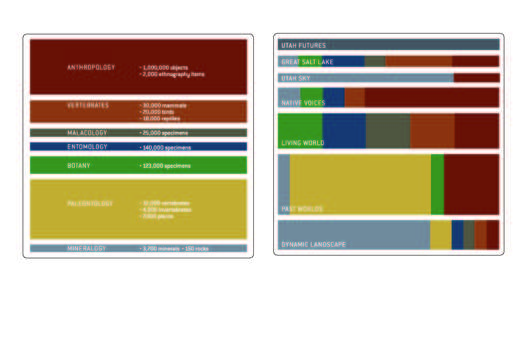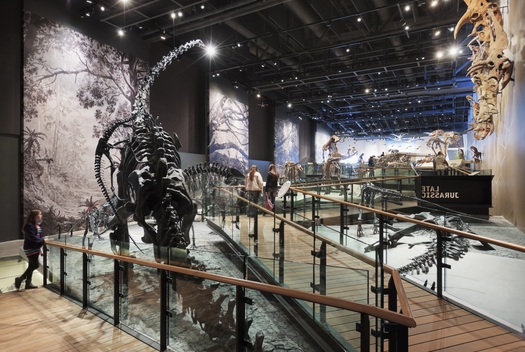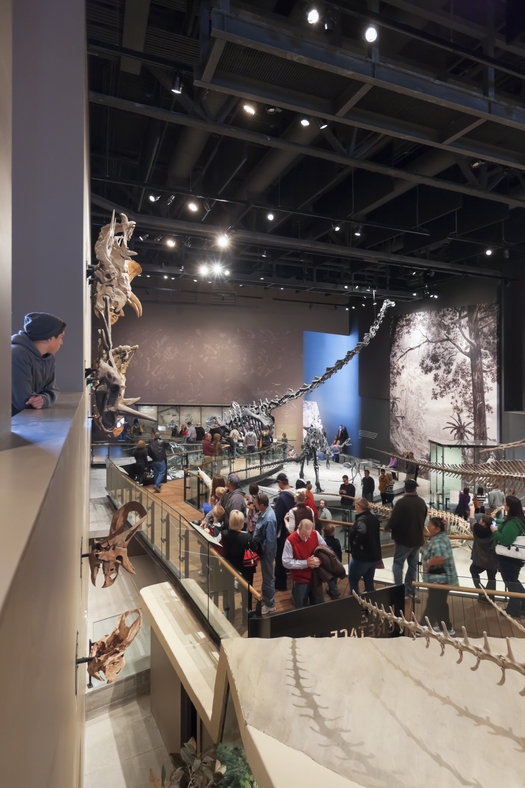 Ennead Architects, Natural History Museum of Utah, Salt Lake City (2012) (Images © Jeff Goldberg/ESTO for Ennead Architects unless otherwise noted)
Ennead Architects, Natural History Museum of Utah, Salt Lake City (2012) (Images © Jeff Goldberg/ESTO for Ennead Architects unless otherwise noted)
There are dinosaurs in Utah.
Not living, of course, but fossils remain in canyons and quarries, washes and 124-million-year-old formations. Twenty years ago, while excavating the spiky, armored anklyosaur later named Gastonia near Arches National Park, scientists found parts of the largest raptor ever discovered, and matched them to a collection of dinosaur fragments found in the 1970s near Moab. The result was a new 20-foot-long predator, a larger cousin of the Deinonychus, soon named Utahraptor. Two years ago, paleontologists found partial fossils of two new members of the Triceratops family in Grand Staircase-Escalante National Monument. They named the larger one Utahceratops gettyi.
Today, the fossil remains of Gryposaurus monumentensis, one of the “duck-billed” dinosaurs, lie under the floor at the new Natural History Museum of Utah in Salt Lake City, arranged the way the museum’s scientists found them at Grand Staircase-Escalante National Monument in the southern part of the state. The fossils are installed under a grid of glass panels, allowing the visitor to come upon them casually, to see how the great beast fell and decayed (a section of skin has been preserved as a texture), before looking ahead, up the exhibition’s winding path, to a hall full of charismatic reconstructions of dinosaurs on the march. A trophy wall of casts of Triceratops skulls provides an instructive look at theme, variation and size; the cast skeleton of a Utahceratops was recently added to the display. In a glassed-in lab, the museum staff works on cleaning and piecing together more fossils in full view of visitors, a tiny taste of the museum’s ongoing and international research.

In these displays, and a thousand others, Ennead Architects’ $103 million Rio Tinto Center works to make natural history seem like the ongoing process of discovery that it is, layering geology and topography, paleontology and interactivity. The building and its exhibits, designed by Ralph Appelbaum Associates, operate within a real landscape that continues to offer up museum-worthy specimens. Connections to that landscape are explicit – the center provides access to existing nature trails that criss-cross the Wasatch Front from each gallery level – and suggestive – the path through the museum’s exhibits is much like a trail itself, ascending 60 feet via ramps, switchbacks and vertiginous bridges across a main hall is shaped like one of Utah’s distinctive slot canyons.
Museum director Sarah George first saw the site, on university-owned land developed as a suburban research park, 20 years ago, when she interviewed for the job. Over the decades she worked to acquire the 17-acre parcel, raise funds from Congress, the state and the county, and conceive of a new museum model. George laughs when I ask her what she knew about architecture when she started (“I’m a biologist!”) but her original requests can clearly be seen in the result.
“The American West is known for its landscape, biota, fossils and native peoples. Back east it is covered with vegetation, and here you can see it all,” George says. “We wanted the building to reflect Utah and then, this was a concrete, specific thing, we didn’t want typical red sandstone. Utah red sandstone is too soft to build with so all the sandstone you see is imported from India. We wanted the building to very continuous with the site.”
 Exhibit Design Prodess by RAA (©Ralph Appelbaum Associates)
Exhibit Design Prodess by RAA (©Ralph Appelbaum Associates)
Appelbaum Associates also contracted directly with the museum, rather than with the architects. They had prepared their first exhibition plan in the 1990s, and a few of those original concepts remain. “We really wanted to get away from -ology galleries,” George says. “The Life gallery talks about land forms and the evolutionary process. That’s not traditional. You don’t go through and peel away layers like you do in a textbook. It is organized by what questions people have.”
The organization of the 163,000-square-foot museum is simple. On the left side, the museum’s offices and storage, arranged on three levels next to a special exhibition gallery and above the museum’s store and café. On the right, what are nominally four levels of permanent exhibitions, ranging from the Past Worlds of the dinosaurs to the Native Voices that exist today, showcased in a circular room with video, artifacts and crafts from Utah’s five Native American nations, Ute, Paiute, Goshute, NW band Shoshone, Navajo. Above the room, out on the hillside, is an amphitheater open to the sky: the public museum’s highest point.
Architect Todd Schliemann arrived early at this organization, based on a diagram of the relative sizes of the museum’s collections and Appelbaum’s division of the galleries, but then considered many different ways of deploying those three long building blocks. He ultimately arrived at a seismic metaphor – another architecturalization of the forces at work on the actual site – first shearing the long blocks in half and away from each other, as if along a fault line, and then angling the resultant halves away from each other, creating the triangular void that became the atrium-as-canyon.

The Canyon (so labeled) serves as an update on the Beaux Arts great hall. In the American Museum of Natural History in New York (to which Ennead and Schliemann added the Rose Center for Earth and Space), that is a tall room at the top of tall stairs, called the Theodore Roosevelt Rotunda. In it you see your first dinosaurs, but you also mill about, collecting tickets and checking coats below the great skeletal beasts. From the great hall you can go west, north or south to the exhibit halls for more. The rooms are used to separate the disciplines and the species, African Mammals from American ones, meteorites from minerals, in the manner of a great filing cabinet. The AMNH has been added on to many times, muddying its organization, but its motley architecture always feels to me like a storehouse or library, filled with things from long ago and far away. There are not dinosaurs in Central Park, even if the paleontologists on staff here, as in Utah, are still on the hunt.
The Canyon is also the center of the Rio Tinto Center, reached up a set of angled steps from the museum’s modest ground-floor admissions desk. But its wings – those sheared bars – are more dynamic. You can go in and out, returning to the Canyon, skipping levels via the elevator, branching off. The building wants to channel you to a continuous path, one which climbs as it instructs. A topographic map inset in the floor in the public part of the Canyon serves as a symbol of and a clue about the internal landscape beyond. The different levels can be glimpsed as diagonals through irregular openings in the Canyon wall, and are suggested by the catwalks overhead and at the end of the narrowing slot. To take the emphasis off the dinosaurs (the museum’s logo appropriates Ennead’s faceted walls rather than the Jurassic Park logo), the Canyon features instead a three-story glass case featuring 500 objects from the collections, graphically displayed. There is a star-patterned Navajo Wedding Basket from the reservation in San Juan County, the massive femur from a Camarasaurus leptus, and a small taxidermied flock of California gulls from northern Utah (the species that, according to legend, descended on the plague of crickets and saved the Mormon pioneers). Twining around these artifacts is a scatter of iridescent butterflies, shining like the gems on level 3. This case presents the riches of the museum aesthetically, emphasizing shape, color, and size over the particularities of category or origin. It is a clue to the overall exhibition method, that of the visual journey, which makes it more difficult to just head to your single topic of interest, and makes it possible to learn without reading a word.

As you ascend, the museum architecture offers framed views of the real-life, right-now version of each topic area. Since it is hard to avoid being drawn to the window first, this allows the landscape to serve as a teaser for its own history, as well as a visual break from the intense information display. In the gallery on the Great Salt Lake, the circular case that offers a liquid demonstration of the lake’s original footprint and shrinkage (you can make it rain!) has an acrylic surround, so the visitor can look past the diorama and out at the diminished lake of today. Underfoot, a terrazzo map shows the receding water lines as well, highlighting your path from the past to the present day Salt Lake City (rendered in squishy gel). The lake gallery serves as the link between the dinosaurs in Past Worlds and the early human civilizations of First Peoples, so the map turns time into space, and offers three different, three-dimensional ways to understand the history of this specific place.
Similar layered moments of past/present day landscape occur in the Land and Sky galleries. In the former, you can either ascend to the Life exhibit through a set of copper-colored switchback ramps, their walls segmented with examples of the real Utah sandstone and photographs of rock faces, or step out onto the Land terrace and walk outside, up a set of concrete steps, to the Life terrace. One wall of the Land gallery is topped with a stepped stack of rock, each layer taken from a different geological formation found in the Grand Staircase-Escalante National Monument. They range in color from bleached white from Straight Cliffs to a purply gray from Tropic. Next to the stack, visitors can make their own mountains of sand and watch the water slice and flatten the contours.
The Sky gallery, on the top floor, is reached by a set of concrete steps that hug the back wall of the Canyon, and then turn toward the front of the museum. Walking up the second run, all one sees is sky through a window that spans the room and fronts a broad terrace. Bracketing that terrace are the museum’s 40,000 square foot solar arrays, which serve a practical as well as a pedagogical purpose, bringing the sky down to the visitor’s level, and illuminating the galleries, via technological innovation. As with the real stone, sand and water in the lower galleries, the sun is made tangible through the architecture, blurring the line between the building and the exhibition.

From that top terrace, you can look across the valley to the 106-year-old Bingham Canyon Mine. And it is from this mine that the museum’s 42,000-square-foot copper carapace comes. The cladding, which covers the upper half of the façade is striated, composed of horizontal bands of different thicknesses and metallic content, ranging from thick strips of warm, reddish copper to thin accents of grayer copper-zinc and copper-tin. All will patinate to a softer greenish hue, so while the museum currently blends with the clay-colored dirt and mountains, it will eventually be closer in coloration to the local underbrush (replicated on the building’s planted roofs) of sedum, bear grass and creeping thyme. The façade is also layered. Its three materials roughly correspond to the structure of the cast-in-place concrete foundation (board-formed concrete), steel columns (vertical corrugated aluminum panels, colored gray), and topping off with the faceted copper cap, whose profile resembles a crude silhouette of the foothills behind it. From afar, and as you drive up the boulevard to Research Park, the museum looks like a hill blurred or pixellated, so that each area of color is both larger and less variegated.
The treatment of the building’s exterior, with its steps and striations and angles, derives from a digital modeling program called Triangular Integrated Networks (TIN) used by Ennead to map landscapes. “We are trying to be more honest about disturbing the landscape, and acknowledge that man is not going to be able to put something back naturally,” says Schliemann. “We decided we would facet it with planes.” He and his team realized that those facets looked like the triangles generated in TIN to approximate real landscape contours through a web of tiny triangles. By increasing the size of the triangles, they generated a roofline, and an interior canyon, that are abstractions of the real thing. “Abstraction in architecture allows different people with different histories and memories to see what they want to see,” he says. “Slot canyons are not all alike: some are shale, some sand, some yellow, some white. The facets let them project the memory they want.”

When Schliemann first showed me the TIN projection, I wondered if he wasn’t putting the technology before the design, succumbing to the allure of quickly pushing and pulling a skin that would cost millions to build. But then I flew in to Salt Lake City, and found the real landscape strangely close to the computer model. The city, built on the flat ground that was once at the bottom of the lake, is a massive grid, accommodating Temple Square and the small downtown, manufacturing zones, and residential streets, marked by an increase in trees. The mountains – the Wasatch range to east, the Oquirrh Mountains to the west, the Traverse Mountains to the south, nearly connecting the two – bump up from the grid abruptly, and the trip to the museum takes you quickly from the flat into the hills, and from a landscape of squares and rectangles to one of triangles. The museum straddles those shapes, more complicated in form than the boxy buildings that are its neighbors, but less complicated than the curves and peaks of the real mountains.
The faceting works here as an indication that the building is still an interpretation rather than a duck: it isn’t supposed to look like a mountain but like the idea of a mountain, and a contemporary one at that. It is architecture rather than papier maché, a building with a contiguous inside and outside rather than a false front or sides. As with the interior Canyon, the design idea is just this side of a theme, but it is the right side. If it were not a museum of natural history but an outlet of Canyon Ranch I might have more questions about the choice. But as a building to educate you about the natural world, a literal and physical bridge between man, knowledge, taxonomy and wildness, Salt Lake City and the Rockies, the facets make sense.
 Simon Heijdens, "Lightweeds," Utah Museum of Natural History (2011) (courtesy Simon Heijdens)
Simon Heijdens, "Lightweeds," Utah Museum of Natural History (2011) (courtesy Simon Heijdens)
The final layer added to the museum’s concatenation of architecture, exhibition design, artifact and interaction is art. The museum’s previous home, a former library on the campus of the University of Utah, contained the beloved 60-by-12-foot Barrier Canyon Mural, painted by Lynn Fausett. In the new museum, the mural is on display in the small lobby, set on rollers so that the section on display can be rotated daily. Inspired by that example, George commissioned twenty-first century equivalents for the new Rio Tinto building.
The most dramatic of these is also the most delicate: artist Simon Heijdens selected four plants from the museum’s herbarium and created algorithms of white light in the shape of each species, allowing them to blow in a digital breeze. The light is projected high on the back wall of the Canyon, raising the fern, aspen and Gambell oak to architectural scale and providing another glimpse of outside life in the most interior part of the museum. The algorithmic plants react to human presence too, bending away from the visitor who approaches the projection. It’s a surprisingly delicate intervention – you wouldn’t want to hang anything on the faceted walls – and one which again upends the identification of natural history with dinosaurs dinosaurs dinosaurs. Utah has them, and so does its Museum of Natural History, but the architecture also absorbs and celebrates natural beauties that are both more fragile and longer lived.
This essay was commissioned by Ennead Architects for a forthcoming volume on the Natural History Museum of Utah, to be published by ORO Editions as part of an ongoing series on the firm's built work.
